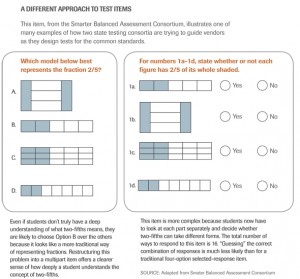Common Core Assessment: What do you think?
The two Common Core assessment consortia, Smarter Balanced and PARCC, have both recently released material giving us an insight into the upcoming Common Core math tests. One of the released items referenced by many articles is the 4th grade fractions question shown here:
This is significantly different from a typical standardized test question in a number of ways:
- There is no calculation to be done. Students have to understand the meaning of fractions as visual models.
- A decision needs to be made about each part of the question. On a typical multiple-choice question, students only have to find one “answer”, so they’re often taught to literally discard the two most unlikely looking responses and then make a best “guess.” This strategy is now, thankfully, rendered completely useless. All four parts of this question could be yes, or all four could be no, or any other combination in between.
- Every part of the question targets some potential misconception.
- 1a is obviously correct, but 1b is not. Even though in both responses 2 out of 5 parts are shaded, the second diagram is not split into equal partitions.
- In 1c, even though 6 boxes are shaded, the students need to understand that this is of visual model of an equivalent fraction to two fifths.
- 1d requires students to clearly understand that a fraction is a means of writing a part-whole ratio rather than a part-part ratio.
This type of question presents a conceptual hurdle for many students, and the big question for schools is how are they going to ensure that they adequately prepare all students for this type of assessment? Blended learning provides a solution.
Dreambox Learning, the only truly adaptive educational program used in Blended Learning models across the county, includes games that would specifically help students be successful on this released item, but also build their overall conceptual understanding of fractions. The program utilizes all current research on mathematical concepts as other programs do but the differentiator for Dreambox is they use over 50,000 pieces of individualized data for each student when presenting them with the next question. Dreambox is game-based learning system that allows all students to learn by doing, solving problems using hands-on visual models and manipulatives. If students solve the question correctly they are rewarded and recognized with badges and the ability to play more games of their choosing, however, if they make a mistake, they receive immediate descriptive feedback, which shows them precisely why their answer was incorrect. This is crucial to child development and mathematical reasoning being developed by our children.


